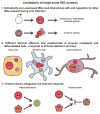New insights into innate immune restriction of West Nile virus infection
- PMID: 25554924
- PMCID: PMC4456296
- DOI: 10.1016/j.coviro.2014.12.001
New insights into innate immune restriction of West Nile virus infection
Abstract
West Nile virus (WNV) is an encephalitic flavivirus that has provided a valuable experimental system for studying viral pathogenesis and immunity. Although in vitro approaches and mouse models of infection have identified pattern recognition receptor and interferon pathways that control WNV infection, our appreciation of specific antiviral effectors has been more limited. In this review, we highlight recent advances in our understanding of the host factors that restrict WNV infection in mammals and insects, especially those resulting from large-scale screening approaches.
Copyright © 2014 Elsevier B.V. All rights reserved.
Figures


References
-
- Suthar MS, Diamond MS, Gale M., Jr West Nile virus infection and immunity. Nat Rev Microbiol. 2013;11:115–128. - PubMed
Publication types
MeSH terms
Grants and funding
LinkOut - more resources
Full Text Sources
Other Literature Sources

